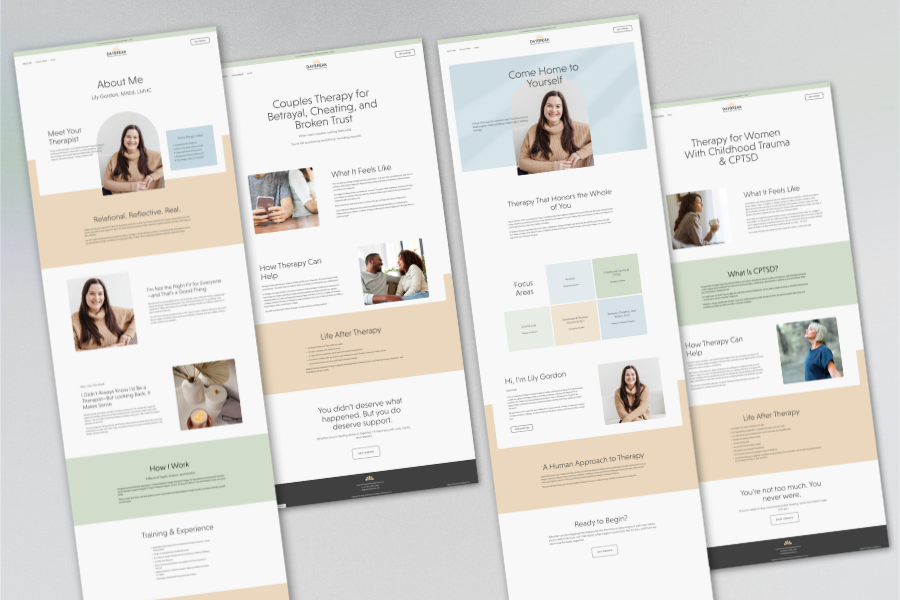Should You Create a Separate Website for Your Consultation or Supervision Services?
Many therapists offer more than one type of service: therapy for clients and professional services like clinical supervision or consultation, or business consultation for fellow therapists. If this describes your practice, you might be wondering—should you promote everything on one website? Or would it make more sense to create a second site just for your work with other professionals?
The answer depends on your goals, how your ideal clients find you, and what role your website plays in your overall marketing strategy. In this post, we’ll walk through the pros and cons of using one site vs. two, explore alternatives if a second website isn’t in the budget, and help you make a clear, confident decision that works for you.
1. Two Very Different Audiences, Two Very Different Needs
Let’s start by looking at who you’re trying to reach.
Your therapy clients are likely searching for someone who feels safe, supportive, and understanding. They want to know that you “get” what they’re going through and that you’re qualified to help.
Your supervision or consultation clients—who are also therapists—are looking for something completely different. They may be newer clinicians who want supervision hours toward licensure, seasoned therapists navigating complex cases, or private practice owners seeking help with business growth. They’re not looking for therapy—they’re looking for guidance from a trusted peer.
Even though both groups might respect your clinical background, they have very different motivations, goals, and questions. That means your messaging, tone, and site structure need to adapt to each audience.
2. Why This Matters for Search Engines (and Your Website’s Effectiveness)
Search engines like Google are designed to deliver the most relevant results to people based on what they’re searching for. The more focused and clear your website is about what you offer and who it’s for, the easier it is for search engines to understand what your site is about—and to match it with the right search terms.
This is where keyword strategy comes in. Keywords are the terms and phrases people type into Google when they’re looking for a service, like:
“Couples Counselor in Austin”
“Clinical supervision for LPC associates”
“Private practice consultation for therapists”
When you create content (like homepage copy, blog posts, or service pages) that intentionally uses the language your ideal client is searching for, Google starts to associate your site with those terms. That’s how you build visibility over time.
But when you try to target two completely different audiences on the same website—for example, therapy clients and therapist consultees—it becomes harder for Google to categorize your site clearly. This is what we mean when we say your site has a “split keyword strategy.”
If your homepage is talking about both therapy for trauma survivors and clinical supervision for new therapists, Google may have a harder time knowing who your site is really for. And people searching for either service may find themselves confused by messaging that doesn’t seem to match their needs.
3. What Happens When You Split Focus?
Let’s talk about what it means to split your focus between two different audiences on one website:
Imagine a 50/50 split, where your website is evenly divided between two types of services. For example, half of your homepage, navigation, or content is focused on attracting therapy clients, and the other half is focused on professional services for other therapists. This kind of setup can confuse both audiences. A potential therapy client may wonder if you're still taking on clients or if your focus has shifted. A therapist looking for supervision might not immediately feel like your site is speaking to their needs.
But with a website closer to an 80/20 split, one audience is clearly prioritized. Maybe 80% of your website is focused on therapy clients, and you have a single, well-structured page for consultation services. This can work—especially if you’re actively marketing that secondary service elsewhere, like on social media or through networking and therapist directories.
The key takeaway is this: The more evenly you split your website between two different client types, the less likely either audience is to feel like your site was made for them. This can reduce trust, engagement, and your ability to rank in search results.
4. When It Makes Sense to Have Two Separate Websites
Creating a second website might be the right move if:
Your therapy services and your consultation/supervision services are both core parts of your business
You want each audience to have a clear, distraction-free experience
You’re relying heavily on your website (and SEO) to bring in new clients for both services
If your marketing strategy centers around organic search, a second site allows you to create focused messaging, dedicated keyword strategies, and content that speaks directly to each group. That’s not only better for SEO—it’s better for your readers, too.
Yes, managing two websites takes more time and investment. But if each service brings in meaningful income, and you’re committed to growing both, the clarity and professionalism that come with separate sites can absolutely be worth it.
5. If a Second Website Isn’t in the Budget: Here Are Two Alternatives
Option 1: Create a Clear, Separate Page for the Secondary Service
This is a great option if one of your services is more of a “side offering,” or if most of your clients for that service come from other places, like word-of-mouth, social media, or direct referrals.
Tips:
Create a distinct page on your website with a clear label in the navigation menu—something like “For Therapists” or “Supervision & Consultation” works well.
Write directly to that audience. Use language that speaks to therapists and clearly explains what you offer, who your services are for, and how they can work with you.
Include all the key details upfront. Make sure the page covers everything a potential consultation or supervision client needs to know: your process, approach, fees, availability, and logistics. That way, they won’t have to dig around your site (or land on therapy-specific pages that don’t apply to them).
Create a separate and clearly labeled contact method. This could be a short form on the page itself or a dedicated email address—something that avoids sending them to your general contact page, which may include language or instructions meant for therapy clients.
Keep the design clean and easy to scan. Think of it like a mini landing page—focused, intentional, and free from distractions.
Even if this page doesn’t rank highly in Google, it gives you a direct link you can share in other places.
Option 2: Promote the Secondary Service Elsewhere Online
Instead of including your supervision or consultation services on your main site, you can create a digital presence for that offering in other places, such as:
Therapist directories (Psychology Today, Therapy Den, etc.)
Social media bios or highlights
LinkedIn
Guest blog posts or podcast appearances
Email newsletters or sub-stacks
These platforms can serve as digital “homes” for your professional services—no full website required.
6. Start With Strategy: There’s No One Right Way
At the end of the day, your decision should come down to your overall marketing strategy and business goals.
If your website is your primary way of bringing in new clients—especially through Google search—then having two focused websites is probably the most effective path.
But if you rely more on referrals, social media, networking, or online communities, and one of your services is clearly secondary, a single site with smart design can work just fine.
The important part is not how many websites you have—it’s that you’ve made an intentional choice based on what’s most likely to support your growth.
Final Thought:
You don’t need to do it all at once. If you’re not ready for a second website today, that doesn’t mean you never will be. As your business evolves, so will your marketing strategy. The best place to start is by asking:
What do I want to be known for, and how do I want people to find me?
From there, you can build a web presence that supports those goals—clearly, confidently, and in your own voice.
Pin it!
Some of My Favorite Private Practice Tools
Resources and Referral Links


































